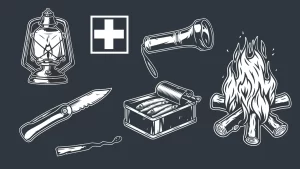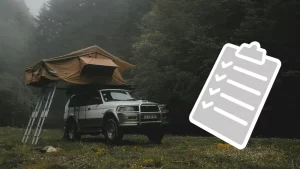Brace yourself, because as temperatures plunge and the darkness creeps in, keeping warm becomes the key to survival in this mad circus we call camping. Heaters are your ticket to fending off the cold. Or are they?
At the height of summer, when the nights are short, a rooftop tent can become a tiny hot space. Doors wide open; widows/vents wide open; skylight rolled back. In the absence of a breeze outside, the interior can be so stifling that sleep remains elusive. Casting your sleeping bag aside and stripping to a minimum doesn’t really make a difference.
So before you even consider a heater, look at the obvious ways to stay warm and reverse your summer technique of trying to stay cool:
- Insulate the tent from all sides, but don’t forget adequate ventilation.
- Layer up. Dress for the occasion. Bottom layers, mid layers, and top layers that you can put on or take off to keep your body temperature comfortable. Don’t forget a warm hat (as most of your heat is lost through your head), gloves and socks.
- A winter sleeping bag
- A warm blanket
- Battery-powered heated blankets and pillows
- Snuggle up to your better half.
Try it before you scoff at the concept, because as tempting as the idea of a heater sounds, this topic isn’t nearly as simple as you might think.
ELECTRIC HEATERS
Not exactly suitable for a rooftop tent. First of all, electric heaters need a fair amount of electricity if they are going to be effective throughout the night. Electric fan heaters are noisy, and they blast out hot air which will also blow dust around. If that isn’t enough to put you off, where are you going to put it? The question is rhetorical because the one risk that really sends up the biggest red flag is: what happens when it falls over at night when you’re fast asleep? A floor covered with soft, dry materials and nobody aware of the fire hazard.
The only reason to use an electric heater in a rooftop tent is to dry it out before putting it into storage. But even then, only when the tent is completely empty—no mattresses or any other items—and under a watchful eye.
GAS HEATERS
Gas, naked flames, carbon monoxide, condensation. Again, in a rooftop tent, it’s a disaster waiting to happen. Don’t even try to find ways to minimise the risk. If you don’t set fire to yourself or asphyxiate, the condensation build-up will create its own nightmare—because the combination of damp and cold is your worst enemy at this time of year.
You can use a gas heater in your well-ventilated annexe, as long as it’s not left unattended. But don’t pull up a chair and doze off. Every year there are reports of people succumbing to asphyxiation in confined spaces with gas heaters turned on.
DIESEL HEATERS
Of all the different types of heaters, one that’s diesel-fired, similar to those found in campervans, is about as feasible as they come. But even then, you need to weigh up the pros and cons carefully.
If your car or van already has a parking heater, then this can simplify things enormously if you can redirect the airflow to the tent. If not, then off-the-shelf diesel heaters are available for rooftop tents. Prices range from around €800 for a basic version to more than double that for a more luxurious model. In theory, you could even buy the components and build one yourself. In simplest terms, they comprise a battery, the heater, a fan, a fuel tank, a hose to feed hot air into the tent, a good length of exhaust hose, and a suitable box in which to assemble it.
The diesel-fired heater gets hot, cold air is drawn into the outer casing, passes the source of the heat, and is blown out by a fan to wherever you have pointed the hot-air hose. The result: hot, dry air accompanied by a certain degree of noise—which can be reduced by fitting a silencer.
The box with all the technology will be outside the tent (so as not to occupy valuable space inside), with the hose entering the through a hole in the tent wall or through a door or window left ajar. You will need to ventilate adequately, and the exhaust hose must be long enough to prevent fumes getting into the tent, the car beneath it, or being sucked in through the heater’s fresh air intake. As a final precaution, you should consider having a carbon monoxide sensor in the tent.
If you can tick all these boxes, then a diesel-fired heater equipped with a remote control is, indeed, a practical solution: it will keep your tent warm and dry.
CONCLUSION
This short article on keeping the winter chills at bay in a rooftop tent might read like a sales pitch for diesel-fired heaters. But when you look at the three different styles of heating, a properly installed diesel is by far the safest, most efficient and cost-effective solution.
Alternatively, you can layer up, insulate your tent, and cuddle with your nearest and dearest.
Safety first!







